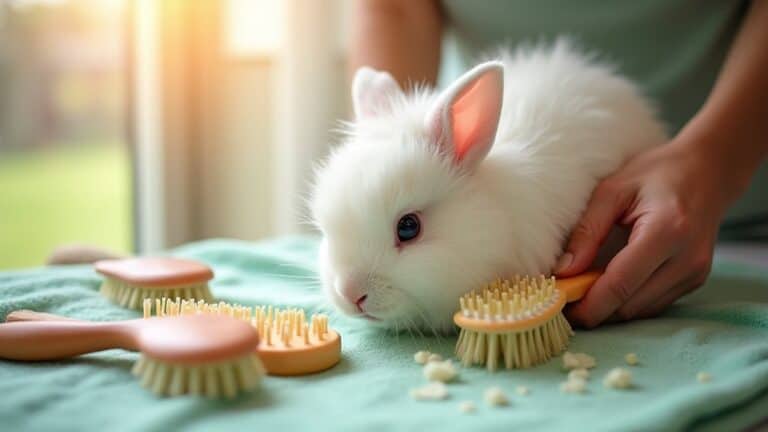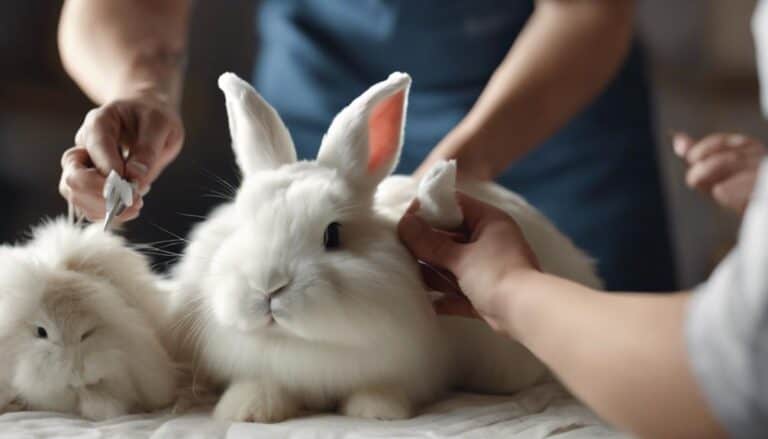Imagine trimming bunny nails is like solving a puzzle—you need patience, precision, and the right approach to guarantee success.
But how do you navigate this delicate task without causing stress or harm to your furry friend?
Let's explore the art of bunny nail trimming, from mastering the technique to understanding the essential tips that can make this grooming routine a breeze for both you and your bunny companion.
Contents
- 1 Key Takeaways
- 2 Necessary Tools for Trimming Bunny Nails
- 3 Partner-Assisted Nail Clipping Technique
- 4 Solo Nail Clipping Method
- 5 Optimal Frequency for Bunny Nail Trims
- 6 Addressing Bleeding or Nail Loss
- 7 Frequently Asked Questions
- 8 Can You Provide Some Tips or Tricks for Trimming Bunny Nails Safely?
- 9 Conclusion
Key Takeaways
- Use specialized rabbit nail clippers for safety and precision.
- Keep rabbits calm and secure during nail trimming.
- Trim nails every 1-2 months to maintain health.
- Be prepared to manage bleeding or nail loss effectively.
Necessary Tools for Trimming Bunny Nails

For essential safety and precision when trimming your rabbit's nails, it's best to use specialized animal nail clippers designed specifically for rabbits. Regular human nail clippers or scissors can cause splintering or injury to your rabbit's nails, so it's important to opt for the right tools.
Spring-loaded dog clippers or scissor clippers with a rounded cutting edge are ideal choices for efficient nail trimming. These specialized tools are designed to make the process easier and safer for both you and your rabbit.
Using the correct clippers helps prevent accidentally cutting the quick of the nail, which can cause bleeding and discomfort for your rabbit. By investing in quality nail clippers meant for rabbits, you guarantee proper nail health and maintenance.
Partner-Assisted Nail Clipping Technique
Utilize a partner to securely hold your rabbit while you trim its nails for a safer and more efficient nail clipping experience. When cutting your rabbit's nails with a partner, follow these tips for a successful nail trimming session:
- Keep Your Rabbit Calm: Make sure your partner helps keep the rabbit calm and relaxed throughout the process to reduce stress and make the experience more pleasant for your furry friend.
- Hold Your Rabbit Securely: Your partner should gently but securely hold the rabbit to prevent sudden movements that could lead to accidental cuts. Using a towel for restraint can help keep the rabbit steady.
- Find the Quick Safely: Work together to locate the quick in each nail before trimming. This will help prevent accidentally cutting the quick and causing discomfort to your rabbit.
Regularly trimming your rabbit's nails with someone to help can make the task easier and less stressful for both you and your pet.
Solo Nail Clipping Method

When clipping bunny nails solo, make sure to maintain a secure grip on the rabbit to facilitate a safe and successful nail trimming process. Rabbits' nails need to be clipped regularly to prevent overgrowth and potential health issues.
To keep your bunny calm during the process, use a towel to gently restrain them while working on a high surface for easier access to their nails. Position your bunny securely to guarantee stability and safety.
Start by cutting a small portion of the nail tip to avoid hitting the quick, which can cause bleeding and discomfort. Monitor your rabbit's comfort level throughout and stop if you notice any signs of distress.
Having treats on hand to reward good behavior can make the experience more positive for your bunny. Remember to stay calm and patient to make it easy for both you and your furry friend.
If bleeding occurs, use styptic powder to stop the bleeding and guarantee a smooth nail clipping session.
Optimal Frequency for Bunny Nail Trims
To maintain your bunny's best nail health and comfort, it's recommended to trim their nails every 1 to 2 months. Consistent nail trimming is essential to prevent overgrowth that can hinder your bunny's mobility and cause foot pad discomfort. Neglecting regular nail trims may result in nails curling or growing into the foot pads, leading to potential pain and injuries. Here are three key points to keep in mind for the best frequency of trimming your rabbits' nails:
- Preventing Overgrowth: Regular nail trims help prevent overgrowth issues that can impact your bunny's ability to move comfortably.
- Ensuring Bunny Mobility: By maintaining an important nail trimming schedule, you're promoting your bunny's agility and preventing any restrictions in movement.
- Avoiding Foot Pad Discomfort: Consistent nail trims reduce the risk of nails growing into the foot pads, which can cause pain and discomfort for your bunny.
Addressing Bleeding or Nail Loss

If your rabbit experiences bleeding or nail loss during trimming, it's important to address the situation promptly and effectively to guarantee their comfort and well-being.
Start by applying gentle pressure with a clean cloth or towel to the bleeding nail. If the bleeding persists, use styptic powder or a styptic pencil to help stop it quickly and effectively.
In the case of a nail coming off, apply styptic powder to the exposed area to aid in clotting. Keeping the rabbit essential during this process to prevent further irritation or injury.
Monitor your rabbit for any signs of discomfort or pain after addressing the bleeding or nail loss during trimming. Remember to keep the environment quiet and soothing to help the rabbit relax.
Frequently Asked Questions
How Do You Cut a Rabbit's Nails at Home?
To cut a rabbit's nails at home, gently restrain your rabbit and use proper clippers to trim small sections of the nail at a time, avoiding the quick. Watch for signs of discomfort, stop if needed. Carefully monitor nail health for regular grooming practices.
What to Do if Your Bunny Won't Let You Cut Their Nails?
If your bunny won't let you cut their nails, stay calm and patient. Use gentle handling tips, offer treat rewards, and seek professional assistance if needed. Incorporate positive reinforcement, practice bonding exercises, and maintain routine nail trimming for their well-being.
Do Rabbits Need Their Nails Trimmed?
To keep your bunny healthy, you must trim their nails regularly. Proper diet, exercise, and grooming routines help. Use nail clippers, quick stop powder, and positive reinforcement. Learn safe handling and nail file usage.
How Do You Tell if a Rabbit's Nails Are Too Long?
To determine if a rabbit's nails are too long, check for nails extending past the fur. Long nails hinder mobility and cause discomfort. Regular nail checking aids in identifying when trimming is needed for best nail health and hygiene.
Can You Provide Some Tips or Tricks for Trimming Bunny Nails Safely?
Yes, it’s important to trim your bunny nails regularly to prevent overgrowth and potential health issues. Some tips for safely trimming bunny nails include using sharp, small clippers, being gentle and patient, and offering treats as a reward. It’s best to consult with a vet or professional for guidance.
Conclusion
To wrap up, trimming your bunny's nails is like giving them a fresh new pair of shoes – it keeps them comfortable, healthy, and ready to hop around with ease.
By using the right tools, technique, and frequency, you can make certain your furry friend stays happy and safe.
Remember to always prioritize their well-being and seek help if needed to make the process as smooth as possible.
Happy trimming!






